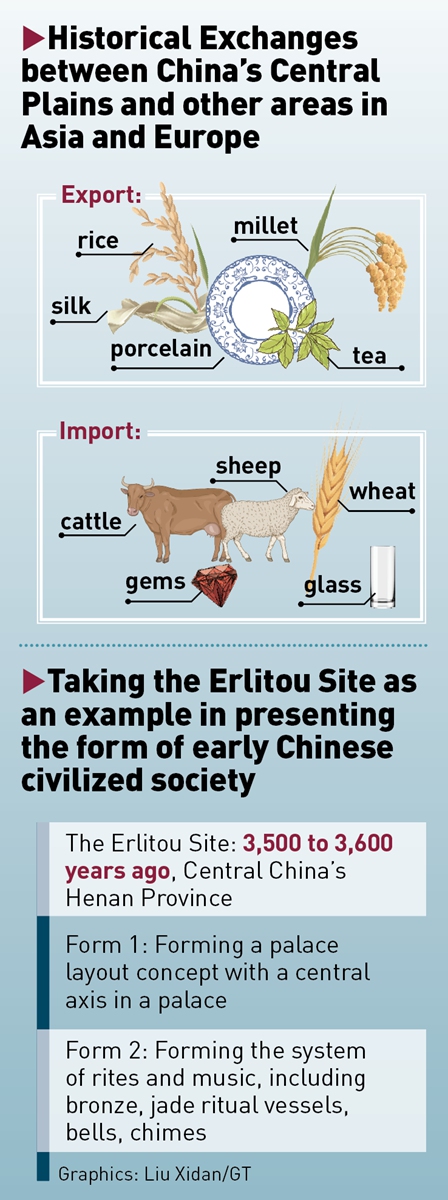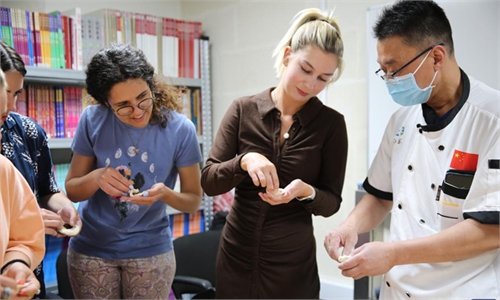ARTS / ART
China’s national program contributes to the world by redefining concept of civilization
A different approach

Crescent Lake in Dunhuang of Northwest China's Gansu Province Photo: VCG
Editor's Note:
Chinese President Xi Jinping recently stressed the importance of furthering the study of Chinese civilization to enhance the historical awareness and cultural confidence of the Communist Party of China (CPC) and society, while unswervingly following the path of socialism with Chinese characteristics to realize national rejuvenation.
Xi, also general secretary of the CPC Central Committee, made the remarks during a group study session of the Political Bureau of the CPC Central Committee on a national research program dedicated to tracing the origins of Chinese civilization.
The Global Times spoke with a number of Chinese scholars and experts, so they break down the large-scale program and give readers a detailed and clear view of its accomplishments.
Chinese archaeologists have noted that since the establishment of the archaeology discipline in China 100 years ago, experts have been exploring the origins of Chinese civilization. To carry forward this spirit, the Chinese government has established a national research program dedicated to studying the development of civilization in China and its roots.
A new standard
Wang Wei, chief expert of the program and President of the Chinese Society of Archaeology, told the Global Times that the national research program breaks through the shackles of Western proposed theories.
"We have established Chinese standard of what is considered a civilized society based on Chinese materials while taking into account the features of other ancient civilizations," Wang said, explaining that the standard involves three phases: development of production, increased population, and the establishment of cities; intensified division of labor and social divisions in society leading to the appearance of classes; strengthened central power resulting in the formation of a monarchy and a state.
Jia Xiaobing, a research fellow at the Chinese Academy of Social Sciences' Institute of Archeology, told the Global Times on Monday that although archaeologists in the West began to explore the origin of civilization earlier than China, their so-called standards of civilization were mostly established based on archaeological discoveries in Europe and the Near East.
However, there have been doubts in the academic field about whether these discoveries have universal significance; and as more discoveries are being made around the world, the limitations of these standards are becoming more obvious.
Australian archaeologist Vere Gordon Childe put forward the theory that there were three criteria for a civilization: metallurgy, writing and urban centers. This theory had extensive influence in academia. However, if we use this theory to examine the origin of Chinese civilization, then early civilized society does not appear until the Shang Dynasty (c.1600BC-1046BC), which does not conform to the practice and understanding of civilization in Chinese archaeology.
"The Chinese plan for the origin of civilization has undoubtedly improved and enriched the theoretical framework for the study of the origins of civilization around the world. It shows that the criteria for civilization are not unique. Different civilizations around the world have their own distinctive characteristics and brilliant achievements, driving forces, mechanisms and paths for their emergence and development," said Jia.
Tradition of inclusiveness
According to Wang, cultural exchanges and mutual learning between the East and the West have continuously played an important role in the development of Chinese civilization.
For example, archaeological studies of Chang'an, capital of the Tang Dynasty (618-907), show that the dynasty had many connections with other nations through the ancient Silk Road. Many people from all over the known world came to China seeking positions within the imperial court or to engage in trade with the dynasty.
The Buddihst monasteries and caves in China represented by the Baima Temple in Luoyang, Central China's Henan Province, and the renowned Dunhuang Grottoes in Northwest China's Gansu Province reflect China's ability to absorb foreign cultural elements and localize them within a short time, such as the integration of the elements of Buddhism from India into China's native Taoism and Confucianism.
"The above examples show Chinese civilization is characterized by continuous and sustainable development, openness and inclusiveness, and diversity," said Wang.
These exchanges are continuing today, especially in the field of archaeology. Shen Ruiwen, dean of the School of Archaeology and Museology at Peking University, told the Global Times that he could feel China's increased global influence as the country often participates in international activities such as exhibitions and exchange programs between universities of China and abroad.
"After a century of development, the Chinese archaeological community has become more international, and its international influence and discourse power have improved. Chinese archaeology is entering its second century and has ushered in a golden age of all-round development," Wang said.





